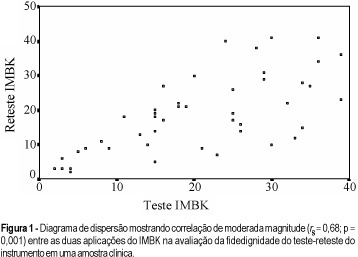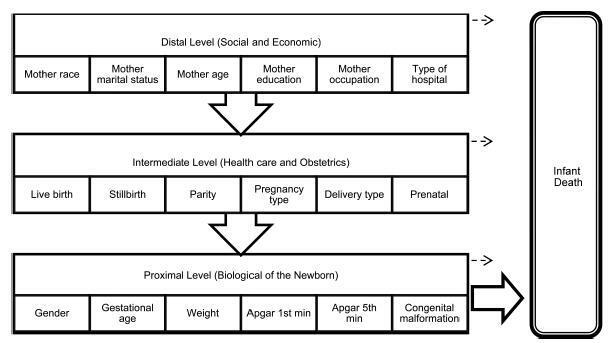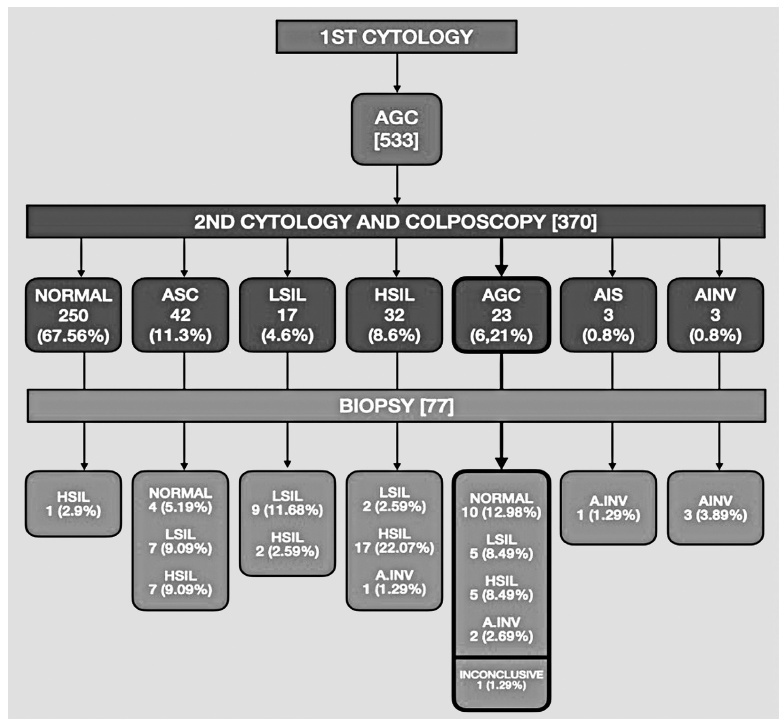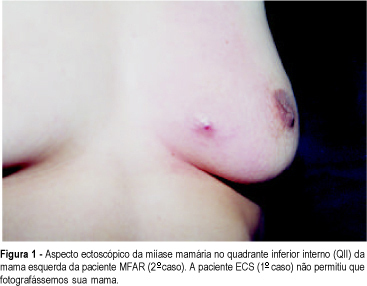Summary
Revista Brasileira de Ginecologia e Obstetrícia. 1998;20(8):481-484
DOI 10.1590/S0100-72031998000800009
Arthrogryposis multiplex congenita is characterized by multiple joint contractures present at birth. Prenatal diagnosis is difficult. There are few reports in the literature. Fetal akinesia, abnormal limb position, intrauterine growth retardation, and polyhydramnios are the main findings of the ultrasonographic diagnosis. The authors describe a case of arthrogryposis multiplex congenita ultrasonographically diagnosed in the third gestational trimester. The main findings were absence of fetal movements, polyhydramnios, symmetrical and non-symmetrical fetal growth retardation with marked decrease of abdominal and thoracic circumference, low-set ears, micrognathia, continuous flexure contracture of limbs, internal rotation of the femur, and clubfoot on the right.

Summary
Revista Brasileira de Ginecologia e Obstetrícia. 2000;22(8):481-487
DOI 10.1590/S0100-72032000000800003
Purpose: based on the knowledge that the reliability of an instrument is essential for a correct interpretation of the results of research, the purpose of the present study is to evaluate the reliability of one of the menopausal indexes more often used in clinical practice and research, the Blatt and Kupperman Menopausal Index (BKMI). Methods: the population consisted of 60 climacteric patients attended at the Gynecology Outpatient Clinic of the Lauro Wanderley University Hospital of the Federal University of Paraíba in João Pessoa city. The reliability coefficient was analyzed by the test-retest method, whose application was done on two different occasions with an interval of four weeks, without administration of medicines. Results: the variation of the score observed with the application of BKMI at the first measurement was 2 to 41, with a median of 18 and mean of 18.8 (± 10.76), while at the second measurement, the menopausal index was 20.2 (± 10.51), median 19, and values ranging from 2 to 39. Despite these results, a Speaman (r s) coefficient of 0.68 (p = 0.001), which is a coefficient of only moderate intensity, was observed. Conclusions: the test-retest reliability in the application of the BKMI shows that, although this instrument presented a statistically moderate reliability, the intensity observed does not represent a reliable measurement. Considering that a correlational study is only a type of screening of the quality of a measurement method, we concluded that other studies must be performed with the purpose of evaluating the reliability and the validity of the BKMI. It is possible that the attribuition of different values to the items of BKMI and the inclusion of symptoms directly related to the estrogenic defficiency, like symptoms of vaginal atrophy, would make the instrument more reliable.

Summary
Revista Brasileira de Ginecologia e Obstetrícia. 2001;23(8):481-488
DOI 10.1590/S0100-72032001000800002
Purpose: to investigate leptin levels in patients with polycystic ovary syndrome (PCOS), and relationships with testosterone, estradiol, follicle-stimulating hormone (FSH) and insulin levels. Methods: transversal study on 40 patients with PCOS divided into two groups: Group I (n = 20)- obese women (body mass index - BMI > or = 28 kg/m²), and Group II (n = 20) - non obese women (BMI <28 kg/m²). Results: BMI was different between the two groups (p=0.04). We observed that leptin concentrations were significantly correlated with BMI (p<0.001). After adjusting for BMI, no correlation between leptin, insulin (p=0.194), FSH (p=0.793), and total (p=0.441) and free (p=0.422) testosterone was found. However, we only observed positive correlations between leptin and estradiol (p=0.043). Conclusions: there is a strong correlation between leptin levels, BMI and estradiol levels in women with PCOS.
Summary
Revista Brasileira de Ginecologia e Obstetrícia. 2016;38(10):482-491
Identify factors associated with infant mortality by a hierarchical model based on socioeconomic, health care, obstetric and biological determinants in a northeastern Brazilian capital.
Observational, retrospective cohort study based on secondary data of births and deaths of infants of mothers living in the city of Teresina.
Based on the distal level of determination of infant mortality, the characteristics that remained statistically significant were maternal age, maternal education and maternal occupation (p< 0.001). In the intermediate level, all variables were statistically significant, particularly the type of pregnancy and delivery (p< 0.001). The gender of the baby was the proximal level feature that had no significant association with the outcome, while the other variables of this level had association (p< 0.001).
This study evidenced that, in addition to biological factors, socioeconomic status and maternal and child health care are important to determine infant mortality.

Summary
Revista Brasileira de Ginecologia e Obstetrícia. 2003;25(7):483-489
DOI 10.1590/S0100-72032003000700004
PURPOSE: to describe the pregnancy outcome of women submitted to cervical cerclage during pregnancy. METHODS: a series of 123 pregnancies in 116 women submitted to elective cervical cerclage by Espinosa-Bahamondes, Palmer and MacDonald techniques and followed at the High-Risk Antenatal Care Unit at CAISM/UNICAMP is described. Variables were analyzed through frequency, mean and standard deviation, comparisons were made using c² or Fisher exact tests. RESULTS: 73% had at least one previous abortion, 17.9% had had 3 prior abortions, and 48% had prior preterm deliveries. The mean gestational age at cerclage was 16 weeks. Cerclage by the Espinosa-Bahamondes technique predominated (94.3%). The overall complication rate was 69%, with preterm labor as the most frequent (31.7%), followed by vaginitis (26%), preterm premature rupture of membranes (10.5%) and fetal death (8.7%). Other clinical complications were less common and included urinary tract infections (5.6%), hypertensive disorders (4%) and gestational diabetes (2.4%). Fetal loss occurred in 8.9% of pregnancies (11 stillbirths). Premature deliveries were present in 18%. History of previous premature deliveries was associated with the occurrence of premature deliveries. CONCLUSION: Obstetrical history compatible with cervical incompetence was frequent, and prior preterm delivery was associated with a preterm delivery in the pregnancy under analysis. The use of cerclage by the Espinosa-Bahamondes technique resulted in 18% of premature newborns, and 104 per thousand rate of perinatal death. Prospective, controlled trials are needed to evaluate the real benefits of cervical cerclage performed during pregnancy.
Summary
Revista Brasileira de Ginecologia e Obstetrícia. 2004;26(6):483-488
DOI 10.1590/S0100-72032004000600010
OBJECTIVE: to determine whether the clinical presentation of hydatidiform mole has changed in the recent years (1992-1998) when compared with historic controls (1960-1981). METHODS: medical records of 80 patients with hydatidiform mole attended in the 1960-1981 period (Group I) were reviewed and compared to data from 801 patients followed in the 1992-1998 period (Group II). The clinical signals and symptoms analyzed were: age distribution, number of pregnancies, vaginal bleeding, hyperemesis, edema, hypertension, large uterus for gestation date and theca lutein cysts of the ovaries. Statistical analyses employed chi-square tests and odds ratio (OR) estimate with the confidence interval (CI) of 95%. RESULTS: concerning age, the disease occurred more frequently in group II than in group I, in patients under 15 and over 40 years old. As to the number of pregnancies, there was no statistical difference only in those patients who were in their third or fourth pregnancies. Arterial hypertension was the only symptom that occurred with similar frequency in both groups. Enlarged uterus was more frequent in group II (41.4 X 31.2% - p <0.05; OR: 1.5; IC: 1.0-2.3). Bleeding remained the most common symptom, occurring in 76.9% of patients (Group II), although it has occurred in 98.7% of the historic controls (p<0.05; OR: 0.04; IC: 0.03 0.04). The following symptoms were also less frequent in group II as compared to group I: hyperemesis (36.5% X 45% - p<0.05; OR: 0.7; IC: 0.4 0.9), edema (12.7% X 20% - p<0.05, OR: 0.5, IC: 0.3 0.8), enlarged uterus for gestational age (41.4% x 31.2% - p<0.05; OR: 1.5; IC: 1.0 2.3) and theca lutein cysts (16.4% X 41.2% - p<0.05; OR: 0.3; IC: 0.2 0.4). Ultrasound has become the commonest method of diagnosis (89.2% - p<0.05), allowing early detection of hydatidiform moles. CONCLUSION: there was a decrease of the traditional symptoms in current patients with hydatidiform mole as compared to historic controls, due to early diagnosis through ultrasonography.
Summary
Revista Brasileira de Ginecologia e Obstetrícia. 2022;44(5):483-488
To determine the prevalence of the atypical glandular cells (AGCs) cytology and to analyze its clinical significance in different age ranges.
Retrospective observational study using computerized data from the Brazilian National Cancer Institute, including women screened between January 2002 and December 2008. The women included were those with an AGC result who were properly followed-up with colposcopy and a second cytology.
A total of 132,147 cytopathological exams were performed during the study period. Five-hundred and thirty-three (0.4%) women with AGC cytology were identified and, of these, 69.41% (370/533) were properly referred for colposcopy and a new cytology. Most of the women (79.2%) with a 1st or 2nd AGC cytology were between the ages of 25 and 54 years. The 2nd cytology demonstrated 67.6% (250/370) of normality, 24.5% (91/370) of squamous atypia, and 6.2% (23/370) of AGC, 0.8% (3/370) adenocarcinoma in situ and 0.8% (3/370) adenocarcinoma invasor. On biopsy of the women with a second AGC cytology, 43.4% (10/23) had normal histology, 43.4% (10/23) had squamous lesions, 8.7% (2/23) had invasive adenocarcinoma, and 1.2% (1/23) had an inconclusive report. All of the women with high-grade squamous intraepithelial lesion (HSIL) or invasive adenocarcinoma (respectively 5 and 2 patients), after a 2nd AGC cytology were 25 years old or older.
The prevalence of the AGC cytology was low in the studied population. Most of the AGC cytology cases occurred in adult women between the ages of 25 and 54. Although most of the patients had normal histology after follow-up, several of them presented with squamous intraepithelial lesions or invasive adenocarcinoma.

Summary
Revista Brasileira de Ginecologia e Obstetrícia. 1999;21(8):483-486
DOI 10.1590/S0100-72031999000800009
SUMMARY Myiasis is defined as a parasitosis caused by the developing larvae of some species of flies that infest humans or animals. The authors present two cases of primary myiasis. They call attention to the characteristics observed in this pathology in the differential diagnosis of the inflammatory diseases in the breast.
